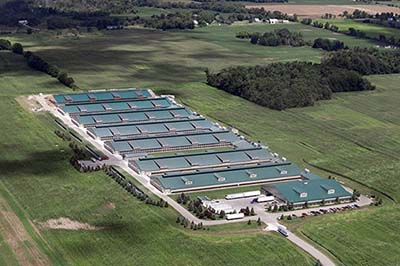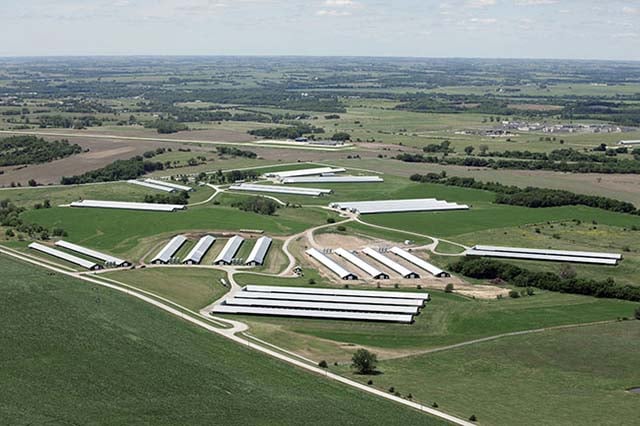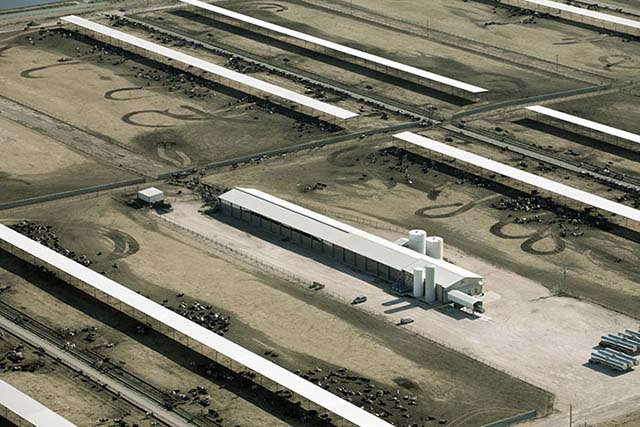
Cornucopia, Wisconsin – The Cornucopia Institute harshly criticized the USDA for its failure to conduct an investigation of 14 legal complaints filed by the Wisconsin-based organic industry watchdog group last December. The complaints allege a systemic pattern of livestock management violations occurring on some of the nation’s biggest certified organic “factory farm” poultry and dairy operations.
In their brief letter to Cornucopia, the National Organic Program’s (NOP) director of Compliance and Enforcement stated that the agency “has determined that an investigation is unwarranted.” Last December, after an investment of seven months and tens of thousands of dollars, Cornucopia filed 14 complaints with the NOP utilizing evidence primarily gathered through high resolution aerial photographic examinations of industrial-scale certified organic dairies and poultry operations. The hundreds of images taken documented an overwhelming absence of dairy cows on pasture, and the exclusive confinement of hundreds of thousands of egg laying hens and meat birds inside buildings.
A related article was produced, today, by the Washington Post, as a follow-up to an exclusive story the paper ran outlining the allegations against the industrial-scale, organic livestock operations, when they were initially filed in December 2014.
“The organic regulations are clear,” said Mark Kastel, Senior Farm Policy Analyst at Cornucopia. “With minor and allowable ‘temporary’ exceptions, dairy cows should be out grazing on pasture and poultry should have access to the outdoors. These operations appear to have miserably failed to meet the criteria.”
Among its justifications for refusing to investigate the complaints, indicated the NOP’s Matthew Michael, was that the photographic evidence was “insufficient” and depicted only a “single moment in time.” He also said that the various operations indicated were “in good standing” with their organic certifiers.
“It must simply be an incredible and amazing coincidence that no birds – zero – were outdoors, and only a fraction of the tens of thousands of cows on the industrial-scale dairies were observed on grass. Most were confined to giant feedlots,” noted Will Fantle, Cornucopia’s Research Director.
“This simply does not pass the smell test,” Fantle added. “Who are you going to believe, the paperwork from the NOP and certifiers, or your own eyes?”
The photos assembled by Cornucopia were gathered by a professional contractor that made the flyovers in the course of its general work ranging from West Texas to the Northeast states, last summer and fall. Cornucopia provided the USDA with hundreds of highly detailed 64 megabyte images that allow for a panoramic view of each operation with the ability to magnify down for ground level detail. One hundred percent (100%) of the images were shared with the NOP.
The detail was so fine that anyone interested in a careful examination could see, for example, that the the vast preponderance of the areas set aside as outdoor runs for poultry flocks was essentially undisturbed. Whether birds were outside or not at the exact moment of the photos, the grounds would clearly show evidence of being foraged and used by thousands of birds if that were occurring.
“When we flew over MBA Poultry, marketing their products under the Smart Chicken brand, at their 40 barns in Nebraska not a single chicken was visible,” added Fantle. The perfectly manicured, undisturbed lawn was observed being mowed at the time.
 Overview of some of the 40 barns at MBA Poultry (dba Smart Chicken) in Tecumseh, Nebraska. On the day of the flyover no chickens were observed outdoors and the meticulously maintained lawn between the buildings was being mowed. The condition of the grass indicated no chickens had been out at any time.
Overview of some of the 40 barns at MBA Poultry (dba Smart Chicken) in Tecumseh, Nebraska. On the day of the flyover no chickens were observed outdoors and the meticulously maintained lawn between the buildings was being mowed. The condition of the grass indicated no chickens had been out at any time.
Besides the photographs contracted for, Cornucopia submitted satellite imagery from additional days all consistently illustrating lack of outdoor access for poultry and gross overstocking on the industrial dairies.
According to Cornucopia’s Kastel, an expert with 25 years of commercial and policy experience related to organic dairy production, “We also submitted copies of state regulatory filings, required for manure/nutrient management on Concentrated Animal Feeding Operations (CAFOs). Based on the extraordinarily crowded conditions, the documents clearly illustrate the fantasy that certifiers could be adequately assuring compliance with grazing requirements.”
Dairies profiled in Cornucopia’s complaints had as many as nine cows per acre designated for grazing. Past national polling indicated that the average certified organic dairy producer maintained about 1 acre of pasture for each cow.
 Aurora Dairy in Stratford, Texas. On the randomly selected day of The Cornucopia Institute’s flyover approximately 98% of their cattle were confined to massive feedlots.
Aurora Dairy in Stratford, Texas. On the randomly selected day of The Cornucopia Institute’s flyover approximately 98% of their cattle were confined to massive feedlots.
“In technical terms, nine cows per acre is a real joke,” Kastel added. “The joke gets funnier when the photographs clearly illustrate these farms were cutting hay on the same ground designated as ‘pasture.'”
Noting that he lacked the documents to pinpoint the percentage of annual growth split between hay production and grazing, Kastel went on to surmise that “if 50% of the annual growth was baled that would equate to an effective stocking rate of 18 cows per acre. We’ve gone from humor to science fiction here. What makes this a tragedy is the USDA, having this evidence, is not even willing to investigate the propriety of these operations.”
According to the NOP’s own procedures for handling complaints that it receives, the agency typically asks an operation’s organic certifier to investigate. This is another problem thatCornucopia contends can influence a full and fair investigation.
“In those instances where it may be possible that the certifier is incompetent, negligent, or even in collusion with the factory farm operator,” suggests Fantle, “we think the USDA has a responsibility to independently investigate when such a broad pattern of abuse is brought to their attention.”
Although the USDA could see no clear violations of the law illustrated in the scores of photographs The Cornucopia Institute submitted, other experts with long-term experience in organic dairying clearly do.
“As someone who actually grazes and manages my dairy herd in accordance with both the spirit and letter of the law, I am outraged by the NOP’s failure to investigate the clear evidence shown in these photographs,” said Kevin Engelbert. Mr. Engelbert and his family manage the nation’s first certified organic dairy farm, located in New York State, and he is also a former member of the National Organic Standards Board.
Added Englebert: “To anyone with any knowledge of agriculture, the aerial photos prove beyond any shadow of a doubt the poultry operations do not provide outdoor access to their birds and the dairy operations are not legitimately grazing their cows. For the NOP to not even investigate these facilities means one of three things: 1) the personnel who made that decision are inept, 2) they are too close and friendly with corporate lobbyists and multi-million-dollar certifiers that are involved in the process, or 3) the most likely scenario, corrupt politicians are preventing them from enforcing the law.”
Consumers have enthusiastically made organics a rapidly growing market sector by supporting farmers and processors that were willing to produce food to a different standard in terms of environmental stewardship, humane animal husbandry, and economic fairness for farmers. Last year $39.1 billion was spent in the organic sector.
One influential observer, the Consumers Union, publisher of Consumer Reports, recently downgraded their rating of the USDA’s organic seal and label. Dr. Urvashi Rangan told the National Organic Standards Board late last year, “Organic is slipping. And as a result, we have downgraded its rating from highly meaningful to meaningful.” Dr. Rangan explained that the role of Consumer Reports “is to help educate people about what organic means as well as what it doesn’t mean.” Rangan is the director of the Consumer Safety and Sustainability Center forConsumer Reports.
“Engaged consumers, who passionately support the ideals and values represented by the organic label, understandably feel betrayed when they see photos of these massive CAFOs masquerading as organic,” Kastel added. “And now the USDA is refusing to even investigate the fraud that appears to be taking place at these giant livestock facilities. How can they be so out of step and tone deaf with regard to consumer expectations?”
Last month, before the current allegations that the USDA is deferring to the interests of corporate organics, Cornucopia asked USDA Secretary Tom Vilsack to remove NOP Staff Director Miles McEvoy due to ethical concerns regarding alleged bending or breaking of the law. This latest action is one more disappointment.
The Cornucopia Institute, thought to have more certified organic farmer members than any similar group, is preparing today an appeal of the complaints dismissal as well as calling for an internal investigation of USDA’s oversight of the organic industry, by the NOP, in a formal request to the agency’s Office of Inspector General.